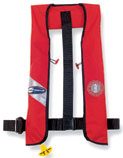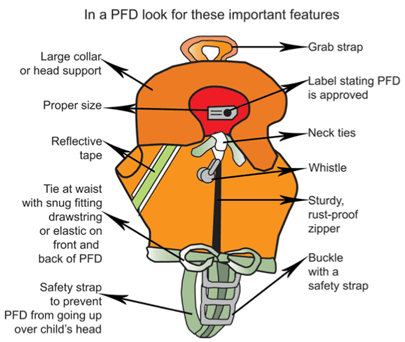Every year in Canada hundreds of Canadians drown while boating. Most of them never intended to be in the water, they were just enjoying their boating activity. Most of them, over 87%, are not wearing a lifejacket or a PFD (or did not have it done up properly) when they drown. (Source: Canadian Red Cross Drowning Report)
When it comes to lifejackets or PFDs, close by isn’t close enough. Choose to WEAR your lifejacket or PFD and make every boating outing a return trip.
Lifejackets vs PFDs
Lifejackets:
A Canadian approved standard lifejacket, when worn properly, is designed to turn an unconscious person from face down to face up in the water, allowing them to breathe. The standard lifejacket is keyhole style and comes in two sizes – one for people who weigh over 40 kg (90 lbs), and one for people who weigh less than 40 kg (90 lbs).
Standard lifejackets must be orange, yellow or red, and have a whistle attached.
Personal Flotation Devices (PFDs):

A Canadian approved PFD is designed to keep you afloat in the water.
PFDs were designed for use in recreational boating and are generally smaller, less bulky and more comfortable than lifejackets. They have less flotation than lifejackets, and have limited turning capacity, but are available in a variety of styles and colours
Inflatable PFDs : An inflatable is a type of personal flotation device that either automatically inflates when immersed in water, or is inflated by the wearer using either an oral or manual inflation device. Most inflatable PFDs use a carbon dioxide cartridge to inflate. Approved inflatable PFDs can be worn if you are 16 years or older and weigh more than 36 kilograms.
Things to consider when choosing a flotation device

- Activities: Consider the water activities that you enjoy. Today there are PFD’s specially designed for various activities including pleasure boating, fishing, water skiing, tubing, kayaking, canoeing and rafting. Note that inflatable lifejackets or PFD’s are not approved for some uses in Canada. Be sure to choose a PFD that meets your particular needs.
- Colour: PFDs are available in many bright colours. The Canadian Coast Guard strongly recommends bright colours for better visibility.
- Size: Sizing is based on chest measurements for adults and weight for children — read the label for details. Try the lifejacket or PFD on. It should fit snugly, with all the buckles, zippers and snaps done up, but still allow room to breathe and move around freely. Try walking and sitting in it too. Your PFD is too big if you can pull it over your ears, and too small if you cannot fasten all buckles and straps.
- Transport Canada Approved: Check the label to make sure the PFD or lifejacket is approved for use in Canada.
Children’s flotation devices
There are approved PFDs and lifejackets designed especially for children. When you purchase a child’s approved flotation device, look for the following:
- Canadian approval labels detailing the appropriate chest size or weight
- A large collar for extra protection and support to the child’s head
- A grab strap on the collar
- Bright colours; yellow, orange or red are most easily seen
- Sturdy, rust-proof buckles and zipper
- Waist ties with snug-fitting drawstrings or elastic in front and back
- A safety strap that fastens between the legs to prevent the device from slipping over the child’s head
- Make sure that the approved flotation device is comfortable, yet snug.
- Do not buy a PFD or lifejacket that is too large in the hope that the child will grow into it.
- Remember that a PFD can never replace adult supervision. Keep your child within arms length at all times when in, on or around the water.
- After you have selected a flotation device for a child, we recommend that you attach reflective tape and a plastic whistle.
Important: In Canada, there are no approved flotation devices for children weighing 20 pounds and under. Transport Canada recommends that you wait until your child reaches 20 lbs. before you go boating with them. For further information, visit Transport Canada.
Visit Mustang Survival to view their full line of Personal Flotation Devices (PFDs).
Testing a lifejacket or PFD
To test your new lifejacket or PFD, take the following steps:
- In a supervised area, put your lifejacket or PFD on and wade out into chest deep water.
- Bend your knees and float on your back.
- Make sure your flotation device keeps your chin above water and you can still breathe easily.
- Practice swimming on your stomach and back.
- If you are responsible for children, let them experiment with their own flotation device under your supervision.
Proper maintenance of a lifejacket or PFD
Proper maintenance of your lifejacket or PFD is very important. A flotation device is designed to save your life and should never be used as a seat cushion or fender for your boat. Using it in this manner could cause damage, voiding its “approved” status.
- Inspect your flotation devices regularly. If there are rips or signs of wear, they should be replaced immediately.
- Store flotation devices on board your boat in a dry, well ventilated area.
- Ensure your flotation devices are readily accessible and stored away from gasoline
To clean a lifejacket or PFD:
- Use mild soap and water.
- Rinse thoroughly.
- Air-dry out of direct sunlight and away from direct heat.
For more information:
- www.wearalifejacket.com (By the Cook-Reese Memorial Fund for Water Search and Safety, a Red Cross partner in safety)
- www.mustangsurvival.com (Mustang Survival, a Red Cross partner in safety)
- www.tc.gc.ca/boatingsafety (Transport Canada)
- Health & safety tips – Lifejacket wear and boating safety

